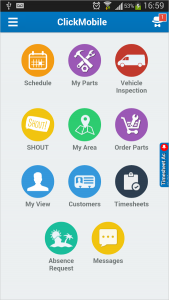 Chances are your business communication syllabus is already packed as you try to cover everything from business English to a wide range of message types to recent advances in digital and social media. It’s a fair question then: Do you really need to find the time and space to add mobile communication to your course?
Chances are your business communication syllabus is already packed as you try to cover everything from business English to a wide range of message types to recent advances in digital and social media. It’s a fair question then: Do you really need to find the time and space to add mobile communication to your course?
We’re adding mobile coverage to our three business communication textbooks based on the same mandate that we’ve always used to modify and expand our coverage over time: anything that is a significant aspect of contemporary business communication should be represented in a textbook on the subject so that students will be aware of it and prepared for it when they enter the workforce.
(With a portfolio of three communication books, we do have the opportunity to adjust what we cover and how deeply. All three books continue to evolve as the field changes, but Business Communication Essentials offers greater focus on business English fundamentals, Excellence in Business Communication is our best fit for mid- and upper-level courses that explore a wide range of writing projects, and Business Communication Today is our full-spectrum text with coverage of everything from brief messages to business video.)
If one accepts the premise that a business communication textbook and course should address all the significant aspects of current professional practice, the next question is whether mobile communication qualifies as significant.
Based on a comprehensive review of academic and trade literature, including numerous surveys regarding adoption of mobile communication, in our view the answer to that question is an undeniable “yes.” Consider these facts and figures (this recent post discusses these phenomena and lists the sources for these statistics):
- Mobile has become the primary communication tool for many business professionals, including a majority of executives under age 40.
- Email and web browsing rank first and second in terms of the most common nonvoice uses of smartphones
- More email messages are now opened on mobile devices than on PCs.
- Roughly half of U.S. consumers use a mobile device exclusively for their online search needs
- Last year, U.S internet users passed the crossover point and now spend more time accessing the Internet from mobile devices than from PCs.
- Many online activities that eventually migrate to a PC screen start out on a mobile screen.
- Globally, roughly 80 percent of Internet users access the web at least some of the time with a mobile device.
Put simply, businesses have no choice but to adopt mobile communication strategies because that’s where an increasing percentage of their customers and their employees expect to find information. After all, there’s not much value in crafting effective messages if the intended audiences never see them. Conventional reports and other documents remain vital, of course, but these days business communication also takes place within mobile apps, on mobile-optimized websites, across location-aware social networks, and in other venues that we couldn’t imagine just a few years ago.
Mobile communication is more than a necessity, however. It’s an exciting opportunity for businesses and, by extension, for all of us involved in helping to develop the next generation of business communicators. Interactive mobile apps, for example, can be a much more effective way to engage and communicate with internal and external stakeholders than conventional print or digital media.
The fundamental communication skills you’ve always taught are still essential, to be sure. In fact, they’re more important than ever, because reading on small screens is more challenging than reading on PCs or paper. Writing audience-oriented messages that are clear, logical, and concise is a make-or-break skill in the mobile environment.
To help you expand your coverage to include mobile, we are integrating mobile communication principles, examples, and techniques throughout our textbooks, as you can see in our new editions of Business Communication Essentials and Business Communication Today. (Excellence in Business Communication, 12th Edition, with full mobile coverage, will be published in January 2016.) We’ve added a variety of model documents, activities, and communication cases that feature mobile. This way, students can learn the fundamentals and have the opportunity to apply them in various media, from conventional printed reports to a wide range of digital media, including mobile devices.
It’s an exciting time to be teaching business communication, and we look forward to supporting you with textbooks that help you prepare students for this new era in business.
Screenshot: ClickSoftware